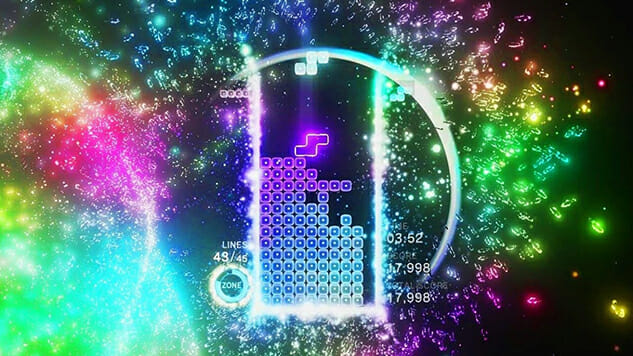
Since I work from home and both write and game on my computer, sometimes it’s a little hard to get my day started. When you can literally roll out of bed each morning straight over to your work station, it tends to cut out some of the important wake up rituals like taking a shower, drinking some coffee, and actually letting your brain restart after a night of hard sleep. If you’re anything like me, sometimes it takes a little something extra to get your head in the game.
Studies have shown that puzzle games, with regular play, may stimulate cognitive function; Tetris, for example, is said by at least one research group to observably improve critical thinking, reasoning, language and processing by creating structural changes in the brain that cause it to operate more efficiently. These same structural changes are associated with mental practice, an internal visualization process that is vital to sports and puzzles of all kinds, whether you’re playing chess or piecing together a 1,000 piece jigsaw with your grandma. It’s also a key element of certain puzzle videogames, a genre that is also often marked by soothing visuals and music, a combination that is highly conducive to the heightened state of focused concentration known as immersion. In many ways, they seem almost built to be a nice little jog for the brain when you’re feeling sluggish.
Over the years I’ve gotten a lot out of sudoku and Brain Age; I started playing them when I got the Nintendo DS and they both were really helpful. My comprehension improved, my response times were quicker, and I felt less brain fog in the morning. As time has gone on, I’ve found some other games that seem to mirror that same state of focused concentration and incorporated them into my daily routine. Here are five of my favorites that you should try.
Tetris Effect
Tetris Effect is absolutely one of my favorite ways to warm my brain up in the morning. Not only does it have some of the best songs and stages of any Tetris game in existence, it’s can be very soothing if you’re still in a post sleep daze (especially when playing some of the cozier ambiant themes, like Forest Dawn or Zen Blossoms). The Journey Mode’s increasing difficulty, meanwhile, features energetic shifts in imagery and music that help gradually increase your consciousness until you’re operating at full capacity. I’m sure Tetris Effect wasn’t deliberately designed to be my perfect morning mental workout, but I’m happy it worked out that way.
Ok, Sokobond is just cool. It’s a puzzle game that is based on chemistry but requires absolutely no understanding of science at all. The goal is to strategically maneuver around the obstacles on the screen to link the atoms according to the number of available bonds. It sounds complicated but it’s really not—the number of available bonds is marked on each atom, and moving them around to create a chain within those parameters is easy to figure out, though a challenge to master. The potential number of connections is modeled after those of actual atoms and molecules, each completed puzzle representing an existing chemical compound—which the game provides more information on once the puzzle is solved.With its calm and simplicity, it’s easy to get lost in this one for hours.
If you like vanilla sudoku but are getting a little bored of it, then Puzlogic might be the one for you. It combines elements of sudoku with kakuro by breaking down the rigidity of grids and adding cross sums to its columns, assigning a number that certain rows must add up to in order to complete the puzzle. The game has 64 levels, all of which are well designed for increasing difficulty, and there are options in the menu to turn off the hints and assign penalties for misplacing a tile, in case you want an additional challenge. Overall it’s a stimulating spin on sudoku that makes the old game seem like new again, and one I recommend.

Like Sokobond, Mitoosis takes its creative cues from science and, as the name suggests, is based on the concept of cell division. The objective is to fill all the open space in each level with yellow or red cells, each of which can be multiplied with a sliding motion to occupy an empty spot. Rows made up of three cells will disappear instantly, which must both be worked around and used to your advantage. With a tutorial so smooth you barely notice it’s there, Mitoosis is smart, fun and uncomplicated, just about everything you want in a puzzle game.
Everything about Lyne is immensely pleasing: the soft jeweled tones of its palette, the pan flute lilt of its soundtrack, even the smooth fluidity of its drag mechanic. It also exhibits an a wordless intuitiveness in its tutorial levels that is impressive as it is easy to understand. In Lyne, the goal is to fill the board by drawing a line from one goal, represented by a shape and color, to another, passing through each matching obstacle while never double crossing. As the levels progress, new shapes with new rules (such as an octagon that must be passed through at least twice) appear, gently increasing the variety and difficulty of the puzzles while retaining its low stress-free atmosphere. And not only are there hundreds of prebuilt puzzles to play, there are infinite procedurally generated ones as well, making it very easy to incorporate Lyne into your morning mental warm-up routine.
Holly Green is the assistant editor of Paste Games and a reporter and semiprofessional photographer. She is also the author of Fry Scores: An Unofficial Guide To Video Game Grub. You can find her work at Gamasutra, Polygon, Unwinnable, and other videogame news publications.